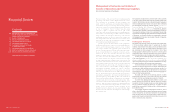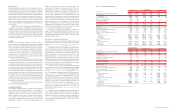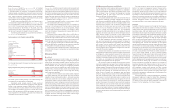Bank of America 2003 Annual Report Download - page 23
Download and view the complete annual report
Please find page 23 of the 2003 Bank of America annual report below. You can navigate through the pages in the report by either clicking on the pages listed below, or by using the keyword search tool below to find specific information within the annual report.
Table 8 presents total long-term debt and other obligations at
December 31, 2003.
Table 8
Long-term Debt and Other Obligations
December 31, 2003
Due in
1 year
(Dollars in millions)
or less Thereafter Total
Long-term debt and
capital leases(1) $12,193 $63,150 $ 75,343
Purchase obligations 14,074 2,850 16,924
Operating lease obligations 1,308 8,075 9,383
Other long-term liabilities 87 – 87
Total $27,662 $74,075 $101,737
(1) Includes principal payments only and capital lease obligations of $26.
Many of our lending relationships contain both funded and unfunded
elements. The funded portion is reflected on our balance sheet. The
unfunded component of these commitments is not recorded on our
balance sheet until a draw is made under the loan facility.
These commitments, as well as guarantees, are more fully dis-
cussed in Note 13 of the consolidated financial statements.
The following table summarizes the total unfunded, or off-bal-
ance sheet, credit extension commitment amounts by expiration
date. Charge cards (nonrevolving card lines) to individuals and gov-
ernment entities guaranteed by the U.S. government in the amount
of $13.7 billion (related outstandings of $233 million) were not
included in credit card line commitments in the table below.
Table 9
Credit Extension Commitments
December 31, 2003
Expires in
1 year
(Dollars in millions)
or less Thereafter Total
Loan commitments(1)
$80,563 $131,218 $211,781
Standby letters of credit and
financial guarantees
19,077 12,073 31,150
Commercial letters of credit
2,973 287 3,260
Legally binding commitments
102,613 143,578 246,191
Credit card lines
84,940 8,831 93,771
Total
$187,553 $152,409 $339,962
(1) Equity commitments of $1,678 related to obligations to fund existing equity investments were
included in loan commitments at December 31, 2003.
On- and Off-balance Sheet Financing Entities
In addition to traditional lending, we also support our customers’
financing needs by facilitating their access to the commercial paper
markets. These markets provide an attractive, lower-cost financing
alternative for our customers. Our customers sell assets, such as
high-grade trade or other receivables or leases, to a commercial
paper financing entity, which in turn issues high-grade short-term
commercial paper that is collateralized by the assets sold.
Additionally, some customers receive the benefit of commercial paper
financing rates related to certain lease arrangements. We facilitate
these transactions and collect fees from the financing entity for the
services it provides including administration, trust services and mar-
keting the commercial paper.
We receive fees for providing combinations of liquidity, standby
letters of credit (SBLCs) or similar loss protection commitments, and
derivatives to the commercial paper financing entities. These forms
of asset support are senior to the first layer of asset support pro-
vided by customers through over-collateralization or by support pro-
vided by third parties. The rating agencies require that a certain
percentage of the commercial paper entity’s assets be supported by
both the seller’s over-collateralization and our SBLC in order to
receive their respective investment rating. The SBLC would be drawn
on only when the over-collateralization provided by the seller and third
parties is not sufficient to cover losses of the related asset. Liquidity
commitments made to the commercial paper entity are designed to
fund scheduled redemptions of commercial paper if there is a market
disruption or the new commercial paper cannot be issued to fund the
redemption of the maturing commercial paper. The liquidity facility
has the same legal priority as the commercial paper. We do not enter
into any other form of guarantee with these entities.
We manage our credit risk on these commitments by subjecting
them to our normal underwriting and risk management processes. At
December 31, 2003 and 2002, the Corporation had off-balance sheet
liquidity commitments and SBLCs to these financing entities of $23.5
billion and $34.2 billion, respectively. Substantially all of these liquid-
ity commitments and SBLCs mature within one year. These amounts
are included in Table 9. $6.4 billion of the decrease in the liquidity
commitments and SBLCs was due to the entities consolidated as a
result of FIN 46. Net revenues earned from fees associated with these
off-balance sheet financing entities were approximately $355 million
and $484 million for 2003 and 2002, respectively.
We generally do not purchase any commercial paper issued by
these financing entities other than during the underwriting process
when we act as issuing agent nor do we purchase any of the com-
mercial paper for our own account. Derivative instruments related to
these entities are marked to market through the statement of income.
SBLCs and liquidity commitments are accounted for pursuant to SFAS
No. 5, “Accounting for Contingencies” (SFAS 5), and are discussed fur-
ther in Note 13 of the consolidated financial statements.
In January 2003, the FASB issued FIN 46 that addresses off-bal-
ance sheet financing entities. We adopted FIN 46 on July 1, 2003
and consolidated approximately $12.2 billion of assets and liabilities
related to certain of our multi-seller asset-backed commercial paper
conduits. There was no material impact to Tier 1 Capital as a result
of consolidation or subsequent deconsolidation and prior periods
were not restated. On October 8, 2003, one of these entities entered
into a Subordinated Note Purchase Agreement with an unrelated third
party. As a result of the sale of the subordinated note to a third party,
we deconsolidated approximately $8.0 billion of the previously con-
solidated conduits. There was no impact to net income as a result of
the deconsolidation. In December 2003, the FASB issued FASB
Interpretation No. 46 (Revised December 2003) “Consolidation of
Variable Interest Entities, an interpretation of ARB No. 51” (FIN 46R).
FIN 46R is an update of FIN 46 and contains different implementa-
tion dates based on the types of entities subject to the standard and
based on whether a company has adopted FIN 46. We anticipate
adopting FIN 46R as of March 31, 2004 and do not expect that it will
have a material impact on our results of operations or financial
condition. There was no material impact to net income as a result
of applying FIN 46 on July 1, 2003. At December 31, 2003, the
remaining consolidated assets and liabilities were reflected in avail-
able-for-sale debt securities, other assets, and commercial paper and
other short-term borrowings in the Global Corporate and Inve stme nt
Banking business segment. As of December 31, 2003, our loss expo-
sure associated with these entities including unfunded lending com-
mitments was approximately $6.4 billion.
In addition, to control our capital position, diversify funding
sources and provide customers with commercial paper investments,
from time to time we will sell assets to off-balance sheet commercial
paper entities. The commercial paper entities are Qualified Special
Purpose Entities that have been isolated beyond our reach or that of
our creditors, even in the event of bankruptcy or other receivership.
Assets sold to the entities consist of high-grade corporate or municipal
bonds, collateralized debt obligations and asset-backed securities.
These entities issue collateralized commercial paper to third party mar-
ket participants and passive derivative instruments to us. Assets sold
to the entities typically have an investment rating ranging from Aaa/AAA
to Aa/AA. We may provide liquidity, SBLCs or similar loss protection
commitments to the entity, or we may enter into derivatives with the
entity in which we assume certain risks. The liquidity facility and deriv-
atives have the same legal standing with the commercial paper.
The derivatives provide interest rate, currency and a pre-speci-
fied amount of credit protection to the entity in exchange for the com-
mercial paper rate. These derivatives are provided for in the legal
documents and help to alleviate any cash flow mismatches. In some
cases, if an asset’s rating declines below a certain investment qual-
ity as evidenced by its investment rating or defaults, we are no longer
exposed to the risk of loss. At that time, the commercial paper hold-
ers assume the risk of loss. In other cases, we agree to assume all
of the credit exposure related to the referenced asset. Legal docu-
ments for each entity specify asset quality levels that require the
entity to automatically dispose of the asset once the asset falls
below the specified quality rating. At the time the asset is disposed,
we are required to reimburse the entity for any credit-related losses
depending on the pre-specified level of protection provided.
We also receive fees for the services we provide to the entities,
and we manage any credit or market risk on commitments or deriva-
tives through normal underwriting and risk management processes.
Derivative activity related to these entities is included in Note 6 of the
consolidated financial statements. At December 31, 2003 and 2002,
the Corporation had off-balance sheet liquidity commitments, SBLCs
and other financial guarantees to the financing entities of $5.4 billion
and $4.5 billion, respectively. Substantially all of these liquidity com-
mitments, SBLCs and other financial guarantees mature within one
year. These amounts are included in Table 9. Net revenues earned
from fees associated with these entities were $50 million and $37
million in 2003 and 2002, respectively.
We generally do not purchase any of the commercial paper
issued by these types of financing entities other than during the
underwriting process when we act as issuing agent nor do we pur-
chase any of the commercial paper for our own account. We do not
consolidate these types of entities because they are considered
Qualified Special Purpose Entities as defined in SFAS 140. Derivative
instruments related to these entities are marked to market through
the statement of income. SBLCs and liquidity commitments are
accounted for pursuant to SFAS 5 and are discussed further in Note
13 of the consolidated financial statements.
Because we provide liquidity and credit support to these financ-
ing entities, our credit ratings and changes thereto will affect the bor-
rowing cost and liquidity of these entities. In addition, significant
changes in counterparty asset valuation and credit standing may also
affect the liquidity of the commercial paper issuance. Disruption in the
commercial paper markets may result in our having to fund under
these commitments and SBLCs discussed above. We manage these
risks, along with all other credit and liquidity risks, within our policies
and practices. See Notes 1 and 9 of the consolidated financial state-
ments for additional discussion of off-balance sheet financing entities.
Capital Management
The final component of liquidity risk is capital management, which
focuses on the level of shareholders’ equity. Shareholders’ equity was
$48.0 billion at December 31, 2003 compared to $50.3 billion at
December 31, 2002, a decrease of $2.3 billion. This decrease was
driven by share repurchases of $9.8 billion, dividends paid of $4.3 bil-
lion and net unrealized losses on derivatives of $2.8 billion offset by
net income of $10.8 billion and common stock issued under employee
plans of $4.2 billion. The net impact to earnings per share of share
repurchases and issuances under employee plans in 2003 was $0.06
per share. We will continue to repurchase shares, from time to time,
in the open market or private transactions through our previously
approved repurchase plan. For additional discussion on share repur-
chases, see Note 14 of the consolidated financial statements.
We have, from time to time, sold put options on our common
stock to independent third parties. The put option program was
designed to partially offset the cost of share repurchases. As of
December 31, 2003, all put options under this program had matured
and there were no remaining put options outstanding. For additional
information on the put option program, see Note 14 of the consoli-
dated financial statements.
As part of the SVA calculation, equity is allocated to business
units based on an assessment of risk. The allocated amount of cap-
ital varies according to the risk characteristics of the individual busi-
ness segments and the products they offer. Capital is allocated
separately based on the following types of risk: credit, market and
operational. Average common equity allocated to business units was
$34.9 billion in 2003 and $35.2 billion in 2002. Average unallocated
common equity (not allocated to business units) was $14.2 billion in
2003 and $12.4 billion in 2002.
As a regulated financial services company, we are governed by
certain regulatory capital requirements. The regulatory Tier 1 Capital
ratio was 7.85 percent at December 31, 2003, a decrease of 37 bps
from a year ago, reflecting higher risk-weighted assets. The minimum
Tier 1 Capital ratio required is four percent. As of December 31, 2003,
we were classified as “well-capitalized” for regulatory purposes, the
highest classification. For additional information on the regulatory cap-
ital ratios along with a description of the components of risk-based
capital, capital adequacy requirements and prompt corrective action
provisions, see Note 15 of the consolidated financial statements.
42 BANK OF AMERICA 2003 BANK OF AMERICA 2003 43
























